Investigating UK Government Strategies for Ovarian Cancer (25-45)
VerifiedAdded on 2021/01/02
|30
|12716
|33
Report
AI Summary
This report investigates the effectiveness of government strategies in tackling ovarian cancer among women aged 25-45 in the UK. The study employs secondary research, utilizing both qualitative and quantitative data from journals, articles, and books. It examines the prevalence of ovarian cancer, explores associated risk factors, and investigates the health implications of the disease. The research highlights the critical need for increased awareness among women for timely diagnosis, emphasizing the importance of government strategies that focus on awareness programs, financial assistance, palliative care, and accessible healthcare services. The report concludes that effective healthcare strategies are essential in preventing ovarian cancer, urging healthcare authorities to collaborate with communities and government policies to enhance healthcare services for women. The introduction outlines the project background, rationale, aim, and objectives, followed by a detailed methodology section describing the study design, literature search strategy, and ethical considerations. The literature review, findings, and discussion cover ovarian cancer causes, health implications, treatment strategies, risk factors, and the effectiveness of government strategies. The report also includes recommendations and methodological reflections.
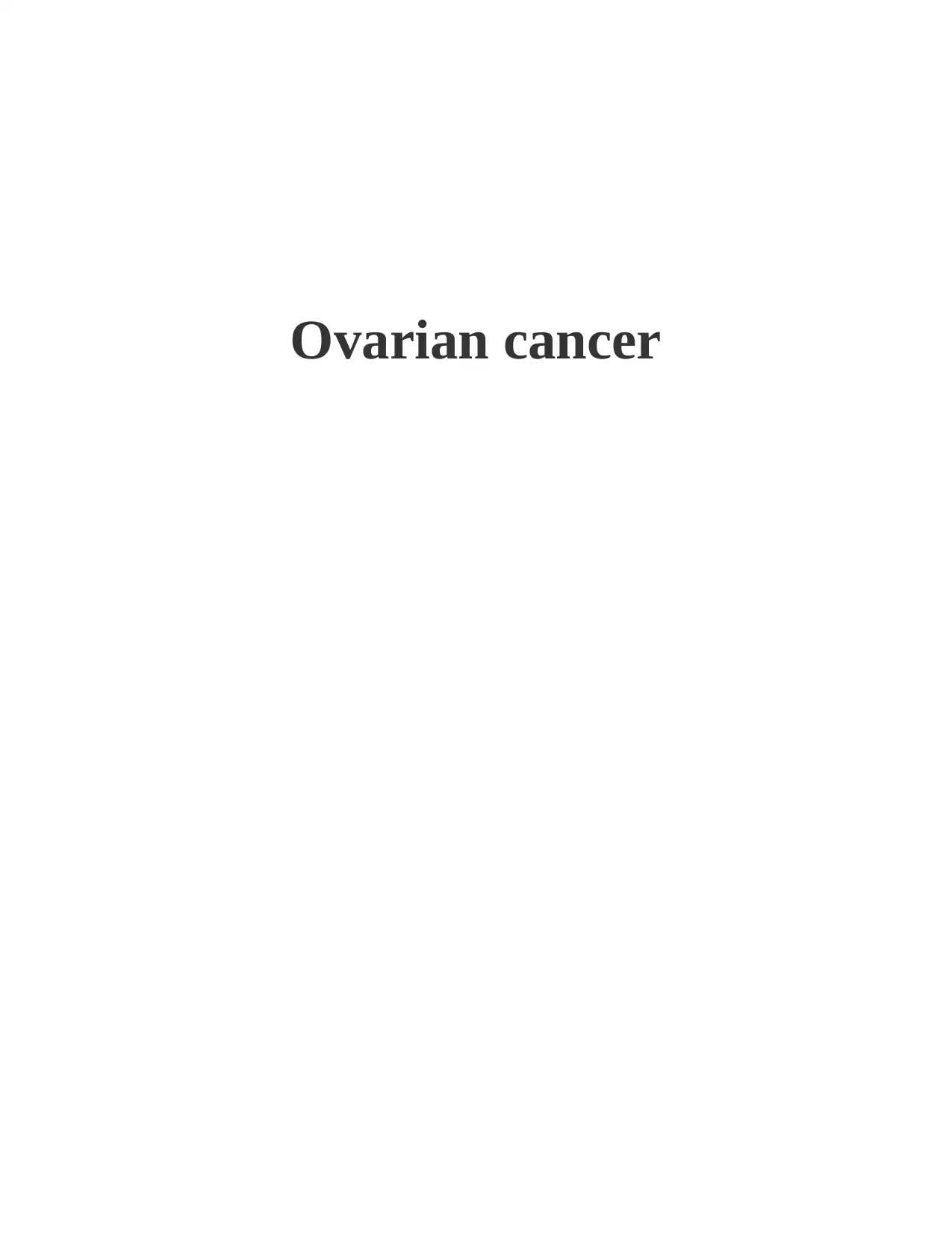
Ovarian cancer
Paraphrase This Document
Need a fresh take? Get an instant paraphrase of this document with our AI Paraphraser
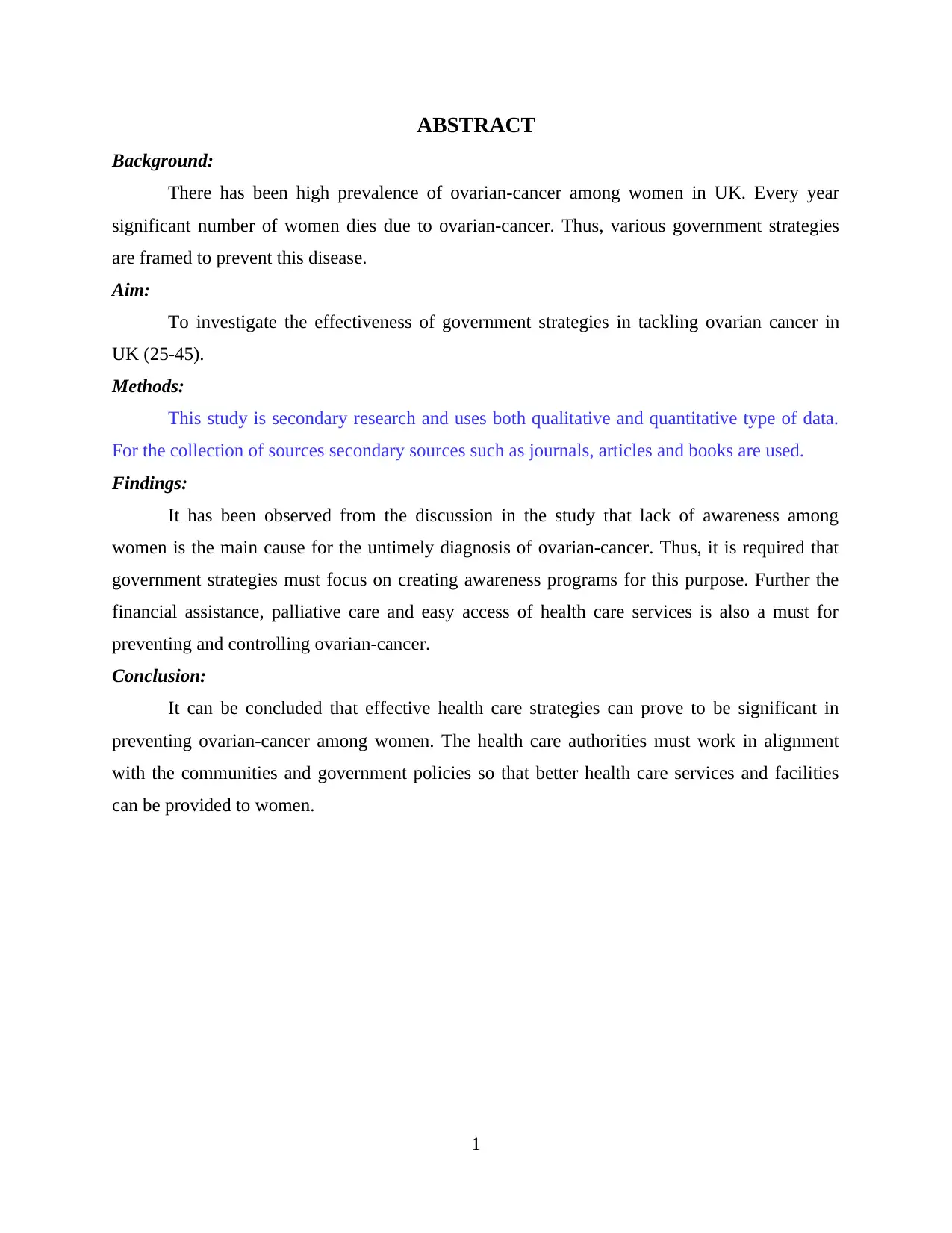
ABSTRACT
Background:
There has been high prevalence of ovarian-cancer among women in UK. Every year
significant number of women dies due to ovarian-cancer. Thus, various government strategies
are framed to prevent this disease.
Aim:
To investigate the effectiveness of government strategies in tackling ovarian cancer in
UK (25-45).
Methods:
This study is secondary research and uses both qualitative and quantitative type of data.
For the collection of sources secondary sources such as journals, articles and books are used.
Findings:
It has been observed from the discussion in the study that lack of awareness among
women is the main cause for the untimely diagnosis of ovarian-cancer. Thus, it is required that
government strategies must focus on creating awareness programs for this purpose. Further the
financial assistance, palliative care and easy access of health care services is also a must for
preventing and controlling ovarian-cancer.
Conclusion:
It can be concluded that effective health care strategies can prove to be significant in
preventing ovarian-cancer among women. The health care authorities must work in alignment
with the communities and government policies so that better health care services and facilities
can be provided to women.
1
Background:
There has been high prevalence of ovarian-cancer among women in UK. Every year
significant number of women dies due to ovarian-cancer. Thus, various government strategies
are framed to prevent this disease.
Aim:
To investigate the effectiveness of government strategies in tackling ovarian cancer in
UK (25-45).
Methods:
This study is secondary research and uses both qualitative and quantitative type of data.
For the collection of sources secondary sources such as journals, articles and books are used.
Findings:
It has been observed from the discussion in the study that lack of awareness among
women is the main cause for the untimely diagnosis of ovarian-cancer. Thus, it is required that
government strategies must focus on creating awareness programs for this purpose. Further the
financial assistance, palliative care and easy access of health care services is also a must for
preventing and controlling ovarian-cancer.
Conclusion:
It can be concluded that effective health care strategies can prove to be significant in
preventing ovarian-cancer among women. The health care authorities must work in alignment
with the communities and government policies so that better health care services and facilities
can be provided to women.
1
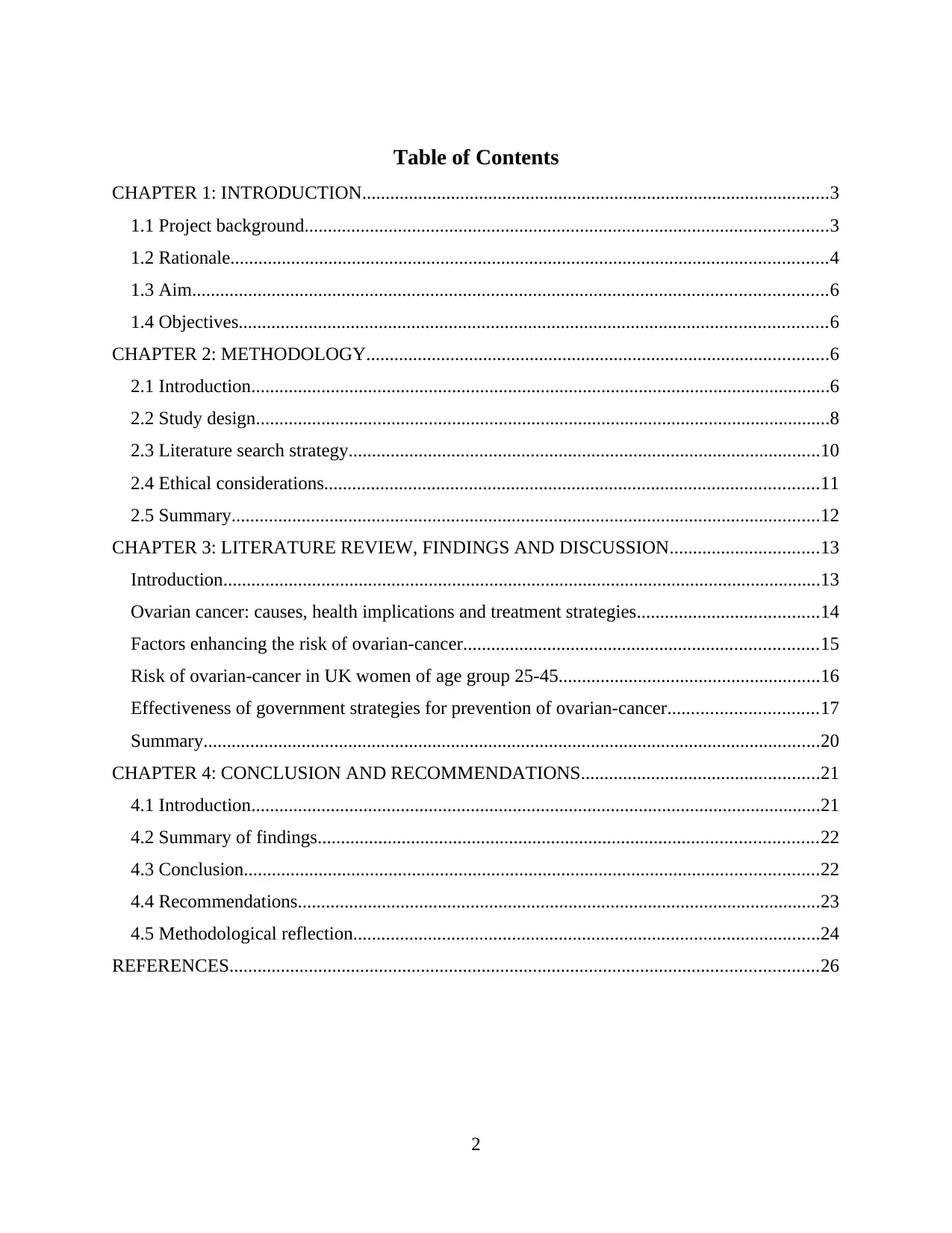
Table of Contents
CHAPTER 1: INTRODUCTION....................................................................................................3
1.1 Project background................................................................................................................3
1.2 Rationale................................................................................................................................4
1.3 Aim........................................................................................................................................6
1.4 Objectives..............................................................................................................................6
CHAPTER 2: METHODOLOGY...................................................................................................6
2.1 Introduction............................................................................................................................6
2.2 Study design...........................................................................................................................8
2.3 Literature search strategy.....................................................................................................10
2.4 Ethical considerations..........................................................................................................11
2.5 Summary..............................................................................................................................12
CHAPTER 3: LITERATURE REVIEW, FINDINGS AND DISCUSSION................................13
Introduction................................................................................................................................13
Ovarian cancer: causes, health implications and treatment strategies.......................................14
Factors enhancing the risk of ovarian-cancer............................................................................15
Risk of ovarian-cancer in UK women of age group 25-45........................................................16
Effectiveness of government strategies for prevention of ovarian-cancer................................17
Summary....................................................................................................................................20
CHAPTER 4: CONCLUSION AND RECOMMENDATIONS...................................................21
4.1 Introduction..........................................................................................................................21
4.2 Summary of findings...........................................................................................................22
4.3 Conclusion...........................................................................................................................22
4.4 Recommendations................................................................................................................23
4.5 Methodological reflection....................................................................................................24
REFERENCES..............................................................................................................................26
2
CHAPTER 1: INTRODUCTION....................................................................................................3
1.1 Project background................................................................................................................3
1.2 Rationale................................................................................................................................4
1.3 Aim........................................................................................................................................6
1.4 Objectives..............................................................................................................................6
CHAPTER 2: METHODOLOGY...................................................................................................6
2.1 Introduction............................................................................................................................6
2.2 Study design...........................................................................................................................8
2.3 Literature search strategy.....................................................................................................10
2.4 Ethical considerations..........................................................................................................11
2.5 Summary..............................................................................................................................12
CHAPTER 3: LITERATURE REVIEW, FINDINGS AND DISCUSSION................................13
Introduction................................................................................................................................13
Ovarian cancer: causes, health implications and treatment strategies.......................................14
Factors enhancing the risk of ovarian-cancer............................................................................15
Risk of ovarian-cancer in UK women of age group 25-45........................................................16
Effectiveness of government strategies for prevention of ovarian-cancer................................17
Summary....................................................................................................................................20
CHAPTER 4: CONCLUSION AND RECOMMENDATIONS...................................................21
4.1 Introduction..........................................................................................................................21
4.2 Summary of findings...........................................................................................................22
4.3 Conclusion...........................................................................................................................22
4.4 Recommendations................................................................................................................23
4.5 Methodological reflection....................................................................................................24
REFERENCES..............................................................................................................................26
2
⊘ This is a preview!⊘
Do you want full access?
Subscribe today to unlock all pages.

Trusted by 1+ million students worldwide
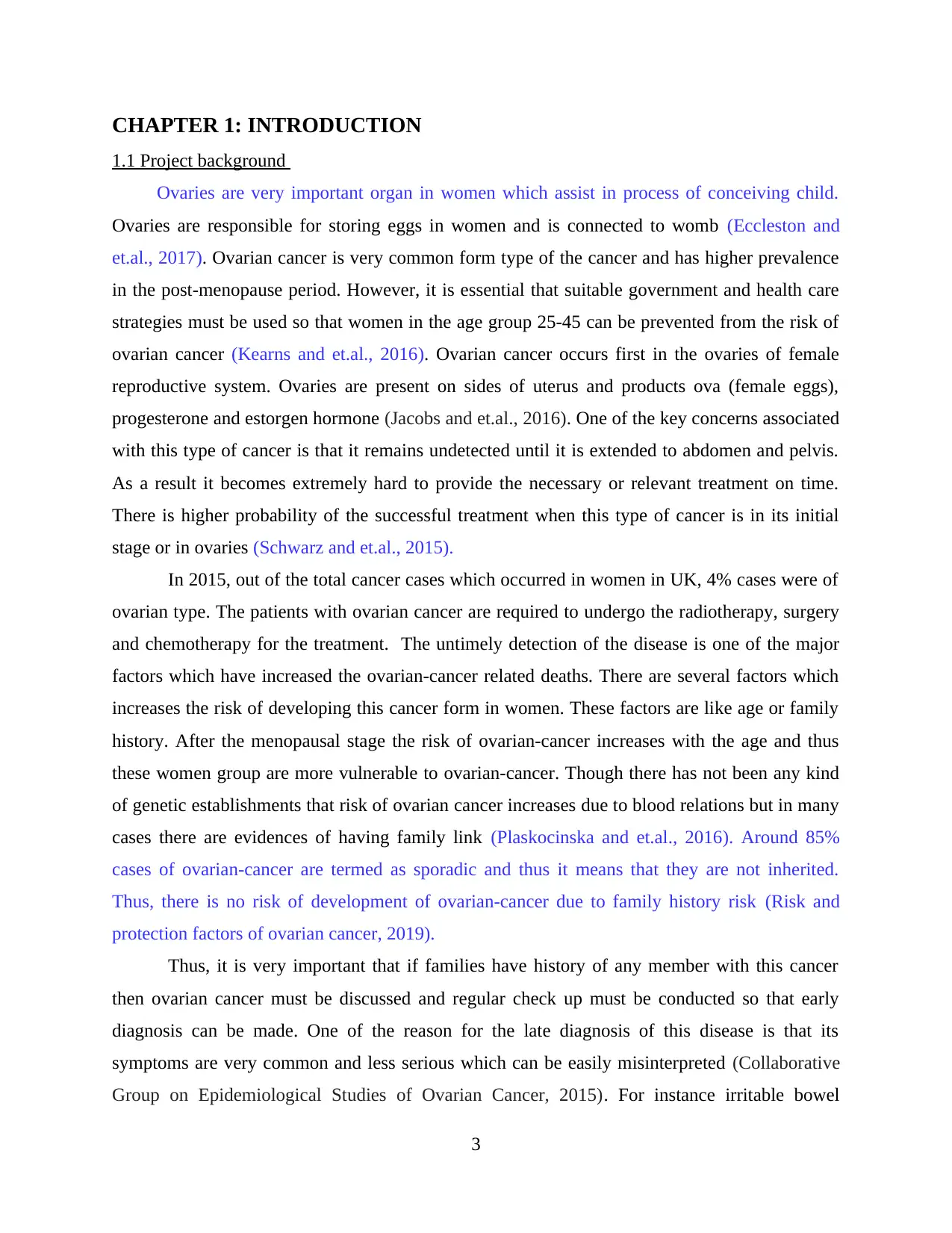
CHAPTER 1: INTRODUCTION
1.1 Project background
Ovaries are very important organ in women which assist in process of conceiving child.
Ovaries are responsible for storing eggs in women and is connected to womb (Eccleston and
et.al., 2017). Ovarian cancer is very common form type of the cancer and has higher prevalence
in the post-menopause period. However, it is essential that suitable government and health care
strategies must be used so that women in the age group 25-45 can be prevented from the risk of
ovarian cancer (Kearns and et.al., 2016). Ovarian cancer occurs first in the ovaries of female
reproductive system. Ovaries are present on sides of uterus and products ova (female eggs),
progesterone and estorgen hormone (Jacobs and et.al., 2016). One of the key concerns associated
with this type of cancer is that it remains undetected until it is extended to abdomen and pelvis.
As a result it becomes extremely hard to provide the necessary or relevant treatment on time.
There is higher probability of the successful treatment when this type of cancer is in its initial
stage or in ovaries (Schwarz and et.al., 2015).
In 2015, out of the total cancer cases which occurred in women in UK, 4% cases were of
ovarian type. The patients with ovarian cancer are required to undergo the radiotherapy, surgery
and chemotherapy for the treatment. The untimely detection of the disease is one of the major
factors which have increased the ovarian-cancer related deaths. There are several factors which
increases the risk of developing this cancer form in women. These factors are like age or family
history. After the menopausal stage the risk of ovarian-cancer increases with the age and thus
these women group are more vulnerable to ovarian-cancer. Though there has not been any kind
of genetic establishments that risk of ovarian cancer increases due to blood relations but in many
cases there are evidences of having family link (Plaskocinska and et.al., 2016). Around 85%
cases of ovarian-cancer are termed as sporadic and thus it means that they are not inherited.
Thus, there is no risk of development of ovarian-cancer due to family history risk (Risk and
protection factors of ovarian cancer, 2019).
Thus, it is very important that if families have history of any member with this cancer
then ovarian cancer must be discussed and regular check up must be conducted so that early
diagnosis can be made. One of the reason for the late diagnosis of this disease is that its
symptoms are very common and less serious which can be easily misinterpreted (Collaborative
Group on Epidemiological Studies of Ovarian Cancer, 2015). For instance irritable bowel
3
1.1 Project background
Ovaries are very important organ in women which assist in process of conceiving child.
Ovaries are responsible for storing eggs in women and is connected to womb (Eccleston and
et.al., 2017). Ovarian cancer is very common form type of the cancer and has higher prevalence
in the post-menopause period. However, it is essential that suitable government and health care
strategies must be used so that women in the age group 25-45 can be prevented from the risk of
ovarian cancer (Kearns and et.al., 2016). Ovarian cancer occurs first in the ovaries of female
reproductive system. Ovaries are present on sides of uterus and products ova (female eggs),
progesterone and estorgen hormone (Jacobs and et.al., 2016). One of the key concerns associated
with this type of cancer is that it remains undetected until it is extended to abdomen and pelvis.
As a result it becomes extremely hard to provide the necessary or relevant treatment on time.
There is higher probability of the successful treatment when this type of cancer is in its initial
stage or in ovaries (Schwarz and et.al., 2015).
In 2015, out of the total cancer cases which occurred in women in UK, 4% cases were of
ovarian type. The patients with ovarian cancer are required to undergo the radiotherapy, surgery
and chemotherapy for the treatment. The untimely detection of the disease is one of the major
factors which have increased the ovarian-cancer related deaths. There are several factors which
increases the risk of developing this cancer form in women. These factors are like age or family
history. After the menopausal stage the risk of ovarian-cancer increases with the age and thus
these women group are more vulnerable to ovarian-cancer. Though there has not been any kind
of genetic establishments that risk of ovarian cancer increases due to blood relations but in many
cases there are evidences of having family link (Plaskocinska and et.al., 2016). Around 85%
cases of ovarian-cancer are termed as sporadic and thus it means that they are not inherited.
Thus, there is no risk of development of ovarian-cancer due to family history risk (Risk and
protection factors of ovarian cancer, 2019).
Thus, it is very important that if families have history of any member with this cancer
then ovarian cancer must be discussed and regular check up must be conducted so that early
diagnosis can be made. One of the reason for the late diagnosis of this disease is that its
symptoms are very common and less serious which can be easily misinterpreted (Collaborative
Group on Epidemiological Studies of Ovarian Cancer, 2015). For instance irritable bowel
3
Paraphrase This Document
Need a fresh take? Get an instant paraphrase of this document with our AI Paraphraser
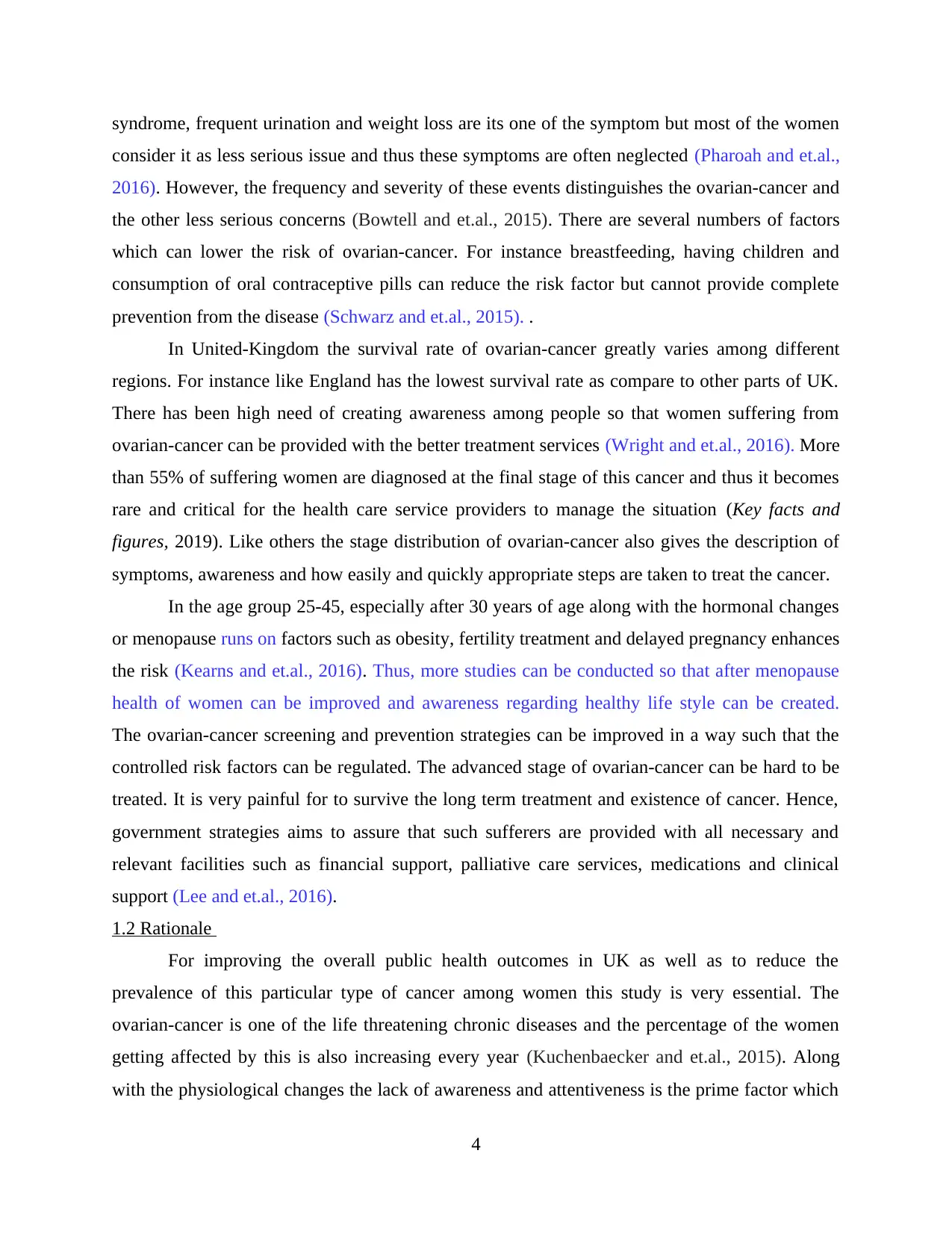
syndrome, frequent urination and weight loss are its one of the symptom but most of the women
consider it as less serious issue and thus these symptoms are often neglected (Pharoah and et.al.,
2016). However, the frequency and severity of these events distinguishes the ovarian-cancer and
the other less serious concerns (Bowtell and et.al., 2015). There are several numbers of factors
which can lower the risk of ovarian-cancer. For instance breastfeeding, having children and
consumption of oral contraceptive pills can reduce the risk factor but cannot provide complete
prevention from the disease (Schwarz and et.al., 2015). .
In United-Kingdom the survival rate of ovarian-cancer greatly varies among different
regions. For instance like England has the lowest survival rate as compare to other parts of UK.
There has been high need of creating awareness among people so that women suffering from
ovarian-cancer can be provided with the better treatment services (Wright and et.al., 2016). More
than 55% of suffering women are diagnosed at the final stage of this cancer and thus it becomes
rare and critical for the health care service providers to manage the situation (Key facts and
figures, 2019). Like others the stage distribution of ovarian-cancer also gives the description of
symptoms, awareness and how easily and quickly appropriate steps are taken to treat the cancer.
In the age group 25-45, especially after 30 years of age along with the hormonal changes
or menopause runs on factors such as obesity, fertility treatment and delayed pregnancy enhances
the risk (Kearns and et.al., 2016). Thus, more studies can be conducted so that after menopause
health of women can be improved and awareness regarding healthy life style can be created.
The ovarian-cancer screening and prevention strategies can be improved in a way such that the
controlled risk factors can be regulated. The advanced stage of ovarian-cancer can be hard to be
treated. It is very painful for to survive the long term treatment and existence of cancer. Hence,
government strategies aims to assure that such sufferers are provided with all necessary and
relevant facilities such as financial support, palliative care services, medications and clinical
support (Lee and et.al., 2016).
1.2 Rationale
For improving the overall public health outcomes in UK as well as to reduce the
prevalence of this particular type of cancer among women this study is very essential. The
ovarian-cancer is one of the life threatening chronic diseases and the percentage of the women
getting affected by this is also increasing every year (Kuchenbaecker and et.al., 2015). Along
with the physiological changes the lack of awareness and attentiveness is the prime factor which
4
consider it as less serious issue and thus these symptoms are often neglected (Pharoah and et.al.,
2016). However, the frequency and severity of these events distinguishes the ovarian-cancer and
the other less serious concerns (Bowtell and et.al., 2015). There are several numbers of factors
which can lower the risk of ovarian-cancer. For instance breastfeeding, having children and
consumption of oral contraceptive pills can reduce the risk factor but cannot provide complete
prevention from the disease (Schwarz and et.al., 2015). .
In United-Kingdom the survival rate of ovarian-cancer greatly varies among different
regions. For instance like England has the lowest survival rate as compare to other parts of UK.
There has been high need of creating awareness among people so that women suffering from
ovarian-cancer can be provided with the better treatment services (Wright and et.al., 2016). More
than 55% of suffering women are diagnosed at the final stage of this cancer and thus it becomes
rare and critical for the health care service providers to manage the situation (Key facts and
figures, 2019). Like others the stage distribution of ovarian-cancer also gives the description of
symptoms, awareness and how easily and quickly appropriate steps are taken to treat the cancer.
In the age group 25-45, especially after 30 years of age along with the hormonal changes
or menopause runs on factors such as obesity, fertility treatment and delayed pregnancy enhances
the risk (Kearns and et.al., 2016). Thus, more studies can be conducted so that after menopause
health of women can be improved and awareness regarding healthy life style can be created.
The ovarian-cancer screening and prevention strategies can be improved in a way such that the
controlled risk factors can be regulated. The advanced stage of ovarian-cancer can be hard to be
treated. It is very painful for to survive the long term treatment and existence of cancer. Hence,
government strategies aims to assure that such sufferers are provided with all necessary and
relevant facilities such as financial support, palliative care services, medications and clinical
support (Lee and et.al., 2016).
1.2 Rationale
For improving the overall public health outcomes in UK as well as to reduce the
prevalence of this particular type of cancer among women this study is very essential. The
ovarian-cancer is one of the life threatening chronic diseases and the percentage of the women
getting affected by this is also increasing every year (Kuchenbaecker and et.al., 2015). Along
with the physiological changes the lack of awareness and attentiveness is the prime factor which
4
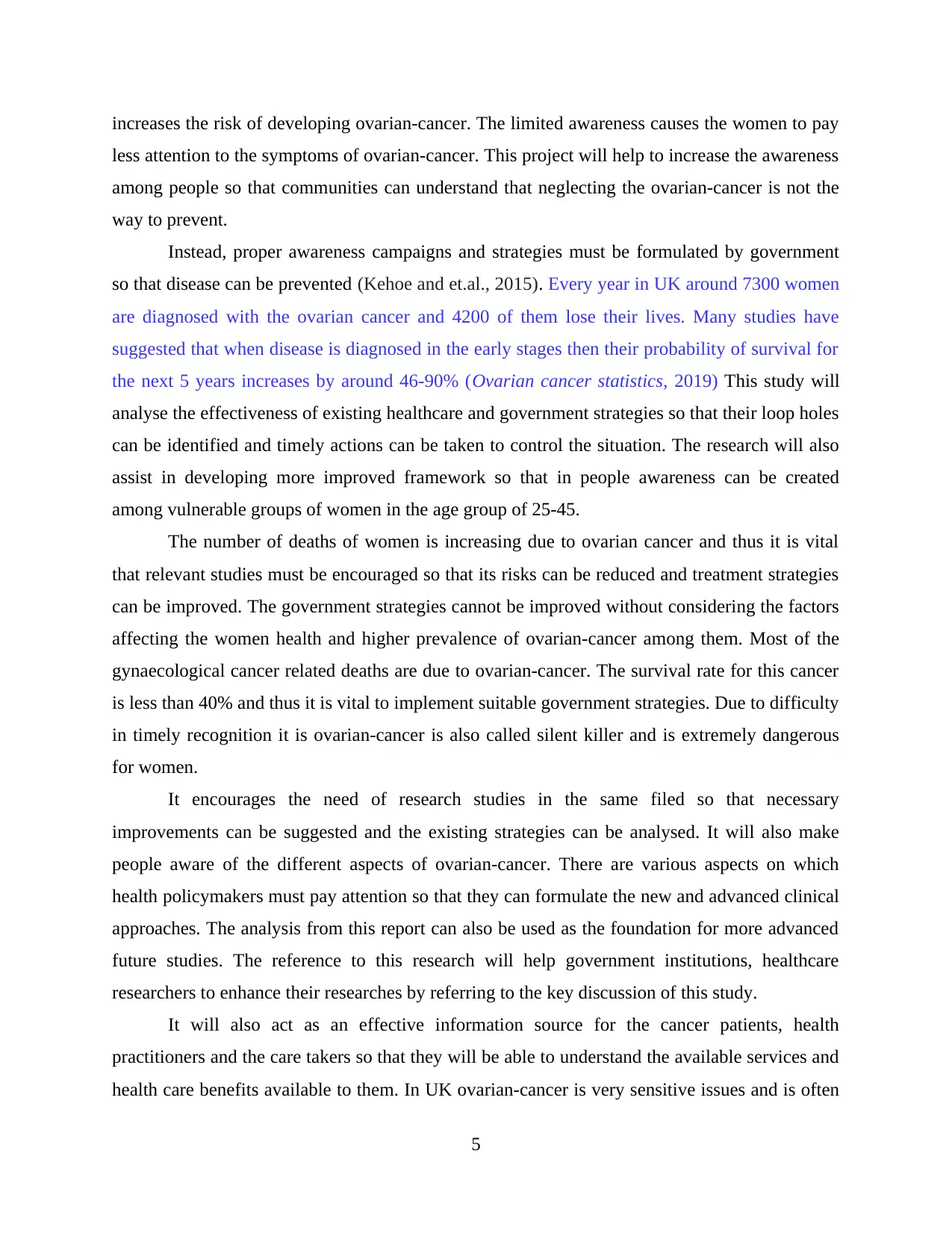
increases the risk of developing ovarian-cancer. The limited awareness causes the women to pay
less attention to the symptoms of ovarian-cancer. This project will help to increase the awareness
among people so that communities can understand that neglecting the ovarian-cancer is not the
way to prevent.
Instead, proper awareness campaigns and strategies must be formulated by government
so that disease can be prevented (Kehoe and et.al., 2015). Every year in UK around 7300 women
are diagnosed with the ovarian cancer and 4200 of them lose their lives. Many studies have
suggested that when disease is diagnosed in the early stages then their probability of survival for
the next 5 years increases by around 46-90% (Ovarian cancer statistics, 2019) This study will
analyse the effectiveness of existing healthcare and government strategies so that their loop holes
can be identified and timely actions can be taken to control the situation. The research will also
assist in developing more improved framework so that in people awareness can be created
among vulnerable groups of women in the age group of 25-45.
The number of deaths of women is increasing due to ovarian cancer and thus it is vital
that relevant studies must be encouraged so that its risks can be reduced and treatment strategies
can be improved. The government strategies cannot be improved without considering the factors
affecting the women health and higher prevalence of ovarian-cancer among them. Most of the
gynaecological cancer related deaths are due to ovarian-cancer. The survival rate for this cancer
is less than 40% and thus it is vital to implement suitable government strategies. Due to difficulty
in timely recognition it is ovarian-cancer is also called silent killer and is extremely dangerous
for women.
It encourages the need of research studies in the same filed so that necessary
improvements can be suggested and the existing strategies can be analysed. It will also make
people aware of the different aspects of ovarian-cancer. There are various aspects on which
health policymakers must pay attention so that they can formulate the new and advanced clinical
approaches. The analysis from this report can also be used as the foundation for more advanced
future studies. The reference to this research will help government institutions, healthcare
researchers to enhance their researches by referring to the key discussion of this study.
It will also act as an effective information source for the cancer patients, health
practitioners and the care takers so that they will be able to understand the available services and
health care benefits available to them. In UK ovarian-cancer is very sensitive issues and is often
5
less attention to the symptoms of ovarian-cancer. This project will help to increase the awareness
among people so that communities can understand that neglecting the ovarian-cancer is not the
way to prevent.
Instead, proper awareness campaigns and strategies must be formulated by government
so that disease can be prevented (Kehoe and et.al., 2015). Every year in UK around 7300 women
are diagnosed with the ovarian cancer and 4200 of them lose their lives. Many studies have
suggested that when disease is diagnosed in the early stages then their probability of survival for
the next 5 years increases by around 46-90% (Ovarian cancer statistics, 2019) This study will
analyse the effectiveness of existing healthcare and government strategies so that their loop holes
can be identified and timely actions can be taken to control the situation. The research will also
assist in developing more improved framework so that in people awareness can be created
among vulnerable groups of women in the age group of 25-45.
The number of deaths of women is increasing due to ovarian cancer and thus it is vital
that relevant studies must be encouraged so that its risks can be reduced and treatment strategies
can be improved. The government strategies cannot be improved without considering the factors
affecting the women health and higher prevalence of ovarian-cancer among them. Most of the
gynaecological cancer related deaths are due to ovarian-cancer. The survival rate for this cancer
is less than 40% and thus it is vital to implement suitable government strategies. Due to difficulty
in timely recognition it is ovarian-cancer is also called silent killer and is extremely dangerous
for women.
It encourages the need of research studies in the same filed so that necessary
improvements can be suggested and the existing strategies can be analysed. It will also make
people aware of the different aspects of ovarian-cancer. There are various aspects on which
health policymakers must pay attention so that they can formulate the new and advanced clinical
approaches. The analysis from this report can also be used as the foundation for more advanced
future studies. The reference to this research will help government institutions, healthcare
researchers to enhance their researches by referring to the key discussion of this study.
It will also act as an effective information source for the cancer patients, health
practitioners and the care takers so that they will be able to understand the available services and
health care benefits available to them. In UK ovarian-cancer is very sensitive issues and is often
5
⊘ This is a preview!⊘
Do you want full access?
Subscribe today to unlock all pages.

Trusted by 1+ million students worldwide
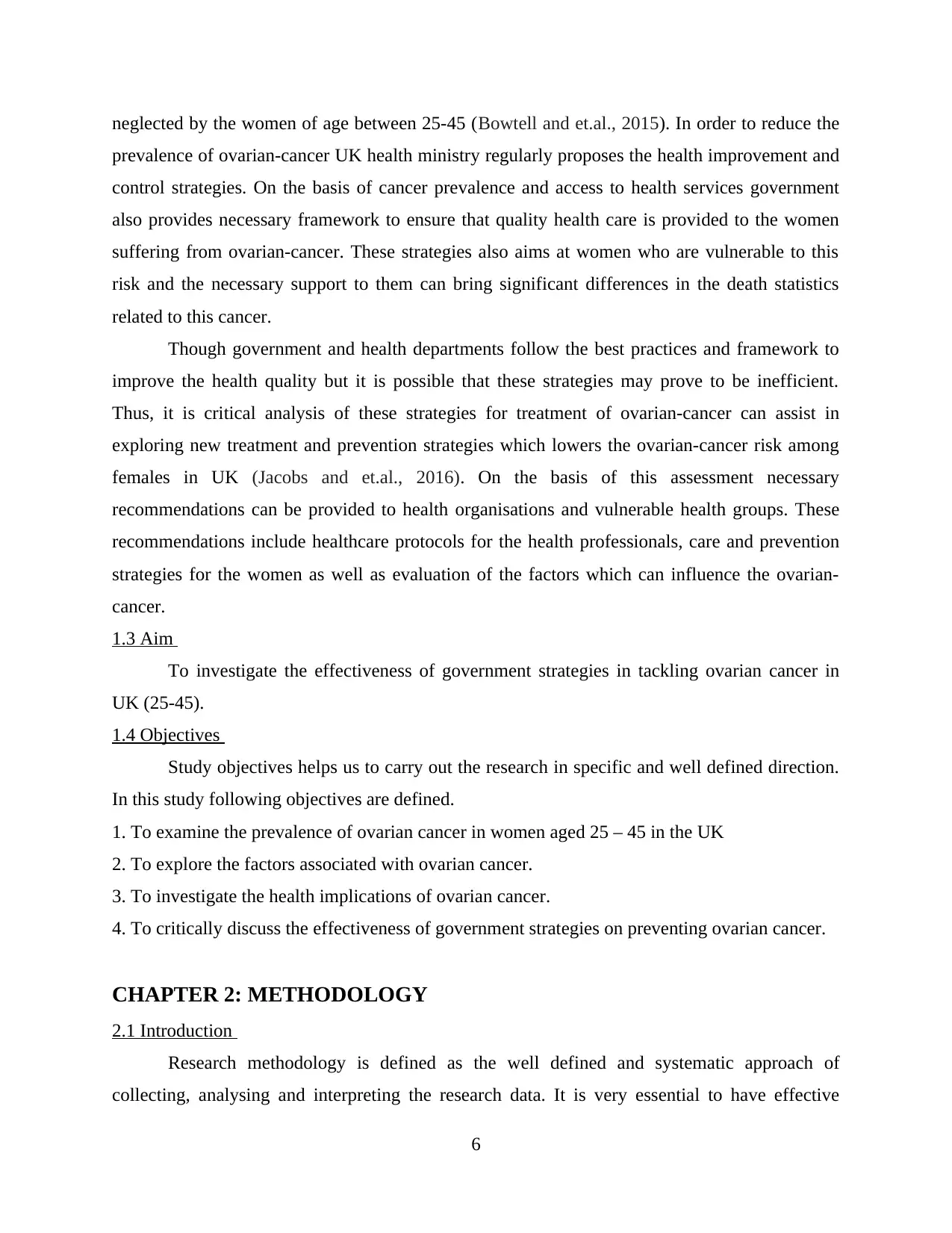
neglected by the women of age between 25-45 (Bowtell and et.al., 2015). In order to reduce the
prevalence of ovarian-cancer UK health ministry regularly proposes the health improvement and
control strategies. On the basis of cancer prevalence and access to health services government
also provides necessary framework to ensure that quality health care is provided to the women
suffering from ovarian-cancer. These strategies also aims at women who are vulnerable to this
risk and the necessary support to them can bring significant differences in the death statistics
related to this cancer.
Though government and health departments follow the best practices and framework to
improve the health quality but it is possible that these strategies may prove to be inefficient.
Thus, it is critical analysis of these strategies for treatment of ovarian-cancer can assist in
exploring new treatment and prevention strategies which lowers the ovarian-cancer risk among
females in UK (Jacobs and et.al., 2016). On the basis of this assessment necessary
recommendations can be provided to health organisations and vulnerable health groups. These
recommendations include healthcare protocols for the health professionals, care and prevention
strategies for the women as well as evaluation of the factors which can influence the ovarian-
cancer.
1.3 Aim
To investigate the effectiveness of government strategies in tackling ovarian cancer in
UK (25-45).
1.4 Objectives
Study objectives helps us to carry out the research in specific and well defined direction.
In this study following objectives are defined.
1. To examine the prevalence of ovarian cancer in women aged 25 – 45 in the UK
2. To explore the factors associated with ovarian cancer.
3. To investigate the health implications of ovarian cancer.
4. To critically discuss the effectiveness of government strategies on preventing ovarian cancer.
CHAPTER 2: METHODOLOGY
2.1 Introduction
Research methodology is defined as the well defined and systematic approach of
collecting, analysing and interpreting the research data. It is very essential to have effective
6
prevalence of ovarian-cancer UK health ministry regularly proposes the health improvement and
control strategies. On the basis of cancer prevalence and access to health services government
also provides necessary framework to ensure that quality health care is provided to the women
suffering from ovarian-cancer. These strategies also aims at women who are vulnerable to this
risk and the necessary support to them can bring significant differences in the death statistics
related to this cancer.
Though government and health departments follow the best practices and framework to
improve the health quality but it is possible that these strategies may prove to be inefficient.
Thus, it is critical analysis of these strategies for treatment of ovarian-cancer can assist in
exploring new treatment and prevention strategies which lowers the ovarian-cancer risk among
females in UK (Jacobs and et.al., 2016). On the basis of this assessment necessary
recommendations can be provided to health organisations and vulnerable health groups. These
recommendations include healthcare protocols for the health professionals, care and prevention
strategies for the women as well as evaluation of the factors which can influence the ovarian-
cancer.
1.3 Aim
To investigate the effectiveness of government strategies in tackling ovarian cancer in
UK (25-45).
1.4 Objectives
Study objectives helps us to carry out the research in specific and well defined direction.
In this study following objectives are defined.
1. To examine the prevalence of ovarian cancer in women aged 25 – 45 in the UK
2. To explore the factors associated with ovarian cancer.
3. To investigate the health implications of ovarian cancer.
4. To critically discuss the effectiveness of government strategies on preventing ovarian cancer.
CHAPTER 2: METHODOLOGY
2.1 Introduction
Research methodology is defined as the well defined and systematic approach of
collecting, analysing and interpreting the research data. It is very essential to have effective
6
Paraphrase This Document
Need a fresh take? Get an instant paraphrase of this document with our AI Paraphraser

research methodologies so that an accurate and most effective blueprint can be obtained for
executing the research with increased validity and accuracy. Research methodology describes the
type of study design which is followed by the researcher. The selection of study design
influences the data collection and analysis methods. Thus, it is vital for the researcher to choose
design which meets the research objectives and goals. Research methodologies also emphasis on
different data collection methods like how data is collected and what interpretation is obtained
from the collected data (Cronin, 2016).
Another important aspect of the research methodology is to assure that ethical
considerations are involved in the research studies (Taylor, Bogdan and DeVault, 2015). The
ethics are vital for the validity of research and thus it is expected that all ethics are followed in
the analysis and data collection methods. This chapter of the study provides a justification of the
primary or secondary design used in the research so that data collection can be accomplish easily
and effectively. The research methodology also describes the search strategies which assist in
enhancing the research experience and findings.
The use of accurate search terms and data base can significantly affect the research
outcomes. As a result, research methodology gives the blueprint of the complete process which
was involved in reaching the research findings. On the basis of comparison between various
methods it becomes easy for the researcher to critically evaluate the strength and weakness of
each of the research methodology and then to choose the best study design and research
strategies which suits the study goals. In other words it makes it easy for the researcher to
achieve all the desired aim and objective that is to be fulfilled in order to complete the research
paper properly and accurately (Norris, 2016).
This research will focus on secondary research data where research data of another
person will be used. Secondary data sources that will be used for this research paper are journals,
articles, newspapers, few government publications, books, online sources etc. All the data or
information collected from secondary research was not the data of recent five years. None of the
older year’s data were used. For this research paper secondary research is used for various
beneficial reasons such as collection of secondary data is much more easier as compared to
primary data and not only this it is both cost and time effective. This secondary data collected
also helps in supporting primary research as well (Wright and et.al., 2016). As this secondary
data is easily available and is verified so it is much more reliable as compared to primary data.
7
executing the research with increased validity and accuracy. Research methodology describes the
type of study design which is followed by the researcher. The selection of study design
influences the data collection and analysis methods. Thus, it is vital for the researcher to choose
design which meets the research objectives and goals. Research methodologies also emphasis on
different data collection methods like how data is collected and what interpretation is obtained
from the collected data (Cronin, 2016).
Another important aspect of the research methodology is to assure that ethical
considerations are involved in the research studies (Taylor, Bogdan and DeVault, 2015). The
ethics are vital for the validity of research and thus it is expected that all ethics are followed in
the analysis and data collection methods. This chapter of the study provides a justification of the
primary or secondary design used in the research so that data collection can be accomplish easily
and effectively. The research methodology also describes the search strategies which assist in
enhancing the research experience and findings.
The use of accurate search terms and data base can significantly affect the research
outcomes. As a result, research methodology gives the blueprint of the complete process which
was involved in reaching the research findings. On the basis of comparison between various
methods it becomes easy for the researcher to critically evaluate the strength and weakness of
each of the research methodology and then to choose the best study design and research
strategies which suits the study goals. In other words it makes it easy for the researcher to
achieve all the desired aim and objective that is to be fulfilled in order to complete the research
paper properly and accurately (Norris, 2016).
This research will focus on secondary research data where research data of another
person will be used. Secondary data sources that will be used for this research paper are journals,
articles, newspapers, few government publications, books, online sources etc. All the data or
information collected from secondary research was not the data of recent five years. None of the
older year’s data were used. For this research paper secondary research is used for various
beneficial reasons such as collection of secondary data is much more easier as compared to
primary data and not only this it is both cost and time effective. This secondary data collected
also helps in supporting primary research as well (Wright and et.al., 2016). As this secondary
data is easily available and is verified so it is much more reliable as compared to primary data.
7
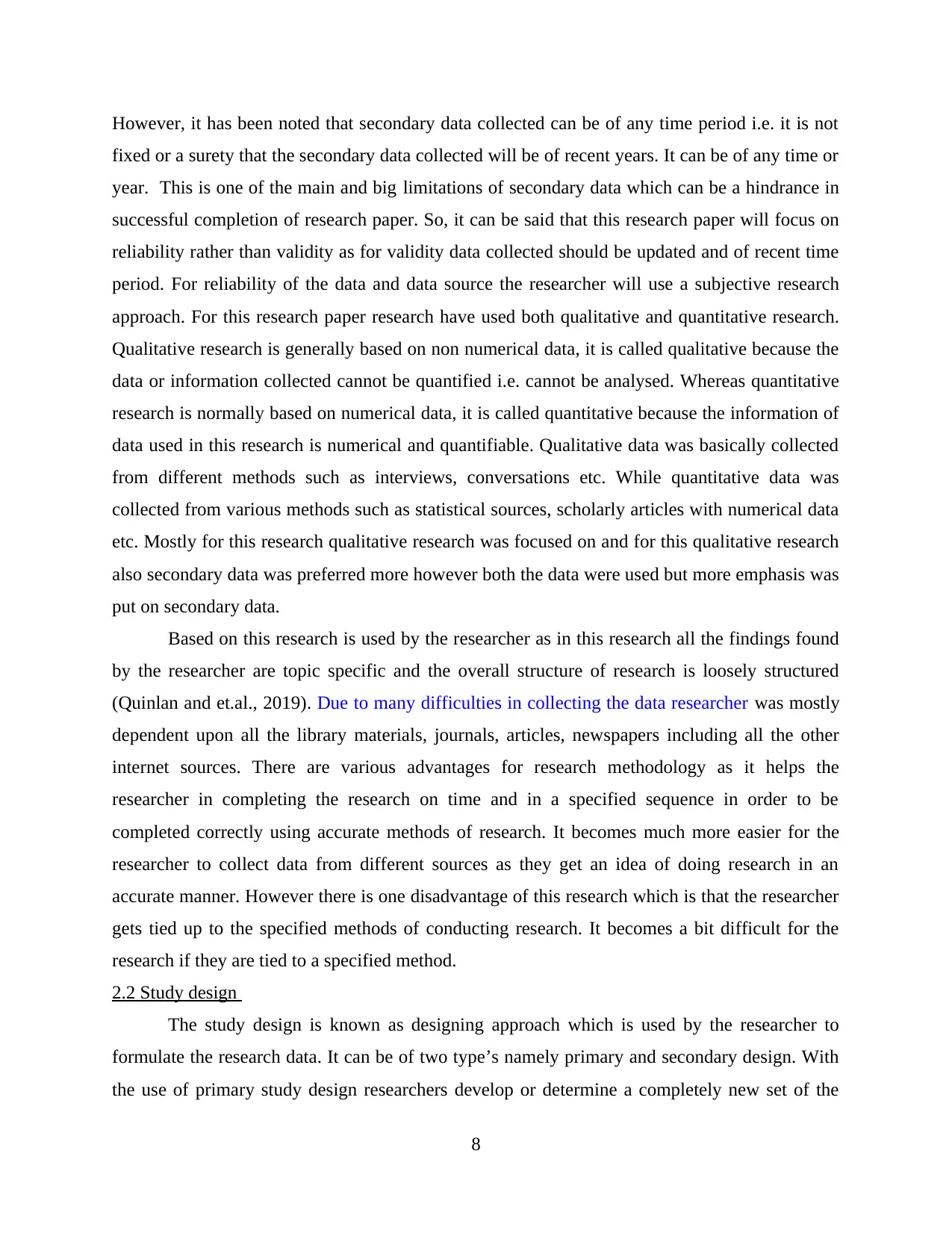
However, it has been noted that secondary data collected can be of any time period i.e. it is not
fixed or a surety that the secondary data collected will be of recent years. It can be of any time or
year. This is one of the main and big limitations of secondary data which can be a hindrance in
successful completion of research paper. So, it can be said that this research paper will focus on
reliability rather than validity as for validity data collected should be updated and of recent time
period. For reliability of the data and data source the researcher will use a subjective research
approach. For this research paper research have used both qualitative and quantitative research.
Qualitative research is generally based on non numerical data, it is called qualitative because the
data or information collected cannot be quantified i.e. cannot be analysed. Whereas quantitative
research is normally based on numerical data, it is called quantitative because the information of
data used in this research is numerical and quantifiable. Qualitative data was basically collected
from different methods such as interviews, conversations etc. While quantitative data was
collected from various methods such as statistical sources, scholarly articles with numerical data
etc. Mostly for this research qualitative research was focused on and for this qualitative research
also secondary data was preferred more however both the data were used but more emphasis was
put on secondary data.
Based on this research is used by the researcher as in this research all the findings found
by the researcher are topic specific and the overall structure of research is loosely structured
(Quinlan and et.al., 2019). Due to many difficulties in collecting the data researcher was mostly
dependent upon all the library materials, journals, articles, newspapers including all the other
internet sources. There are various advantages for research methodology as it helps the
researcher in completing the research on time and in a specified sequence in order to be
completed correctly using accurate methods of research. It becomes much more easier for the
researcher to collect data from different sources as they get an idea of doing research in an
accurate manner. However there is one disadvantage of this research which is that the researcher
gets tied up to the specified methods of conducting research. It becomes a bit difficult for the
research if they are tied to a specified method.
2.2 Study design
The study design is known as designing approach which is used by the researcher to
formulate the research data. It can be of two type’s namely primary and secondary design. With
the use of primary study design researchers develop or determine a completely new set of the
8
fixed or a surety that the secondary data collected will be of recent years. It can be of any time or
year. This is one of the main and big limitations of secondary data which can be a hindrance in
successful completion of research paper. So, it can be said that this research paper will focus on
reliability rather than validity as for validity data collected should be updated and of recent time
period. For reliability of the data and data source the researcher will use a subjective research
approach. For this research paper research have used both qualitative and quantitative research.
Qualitative research is generally based on non numerical data, it is called qualitative because the
data or information collected cannot be quantified i.e. cannot be analysed. Whereas quantitative
research is normally based on numerical data, it is called quantitative because the information of
data used in this research is numerical and quantifiable. Qualitative data was basically collected
from different methods such as interviews, conversations etc. While quantitative data was
collected from various methods such as statistical sources, scholarly articles with numerical data
etc. Mostly for this research qualitative research was focused on and for this qualitative research
also secondary data was preferred more however both the data were used but more emphasis was
put on secondary data.
Based on this research is used by the researcher as in this research all the findings found
by the researcher are topic specific and the overall structure of research is loosely structured
(Quinlan and et.al., 2019). Due to many difficulties in collecting the data researcher was mostly
dependent upon all the library materials, journals, articles, newspapers including all the other
internet sources. There are various advantages for research methodology as it helps the
researcher in completing the research on time and in a specified sequence in order to be
completed correctly using accurate methods of research. It becomes much more easier for the
researcher to collect data from different sources as they get an idea of doing research in an
accurate manner. However there is one disadvantage of this research which is that the researcher
gets tied up to the specified methods of conducting research. It becomes a bit difficult for the
research if they are tied to a specified method.
2.2 Study design
The study design is known as designing approach which is used by the researcher to
formulate the research data. It can be of two type’s namely primary and secondary design. With
the use of primary study design researchers develop or determine a completely new set of the
8
⊘ This is a preview!⊘
Do you want full access?
Subscribe today to unlock all pages.

Trusted by 1+ million students worldwide
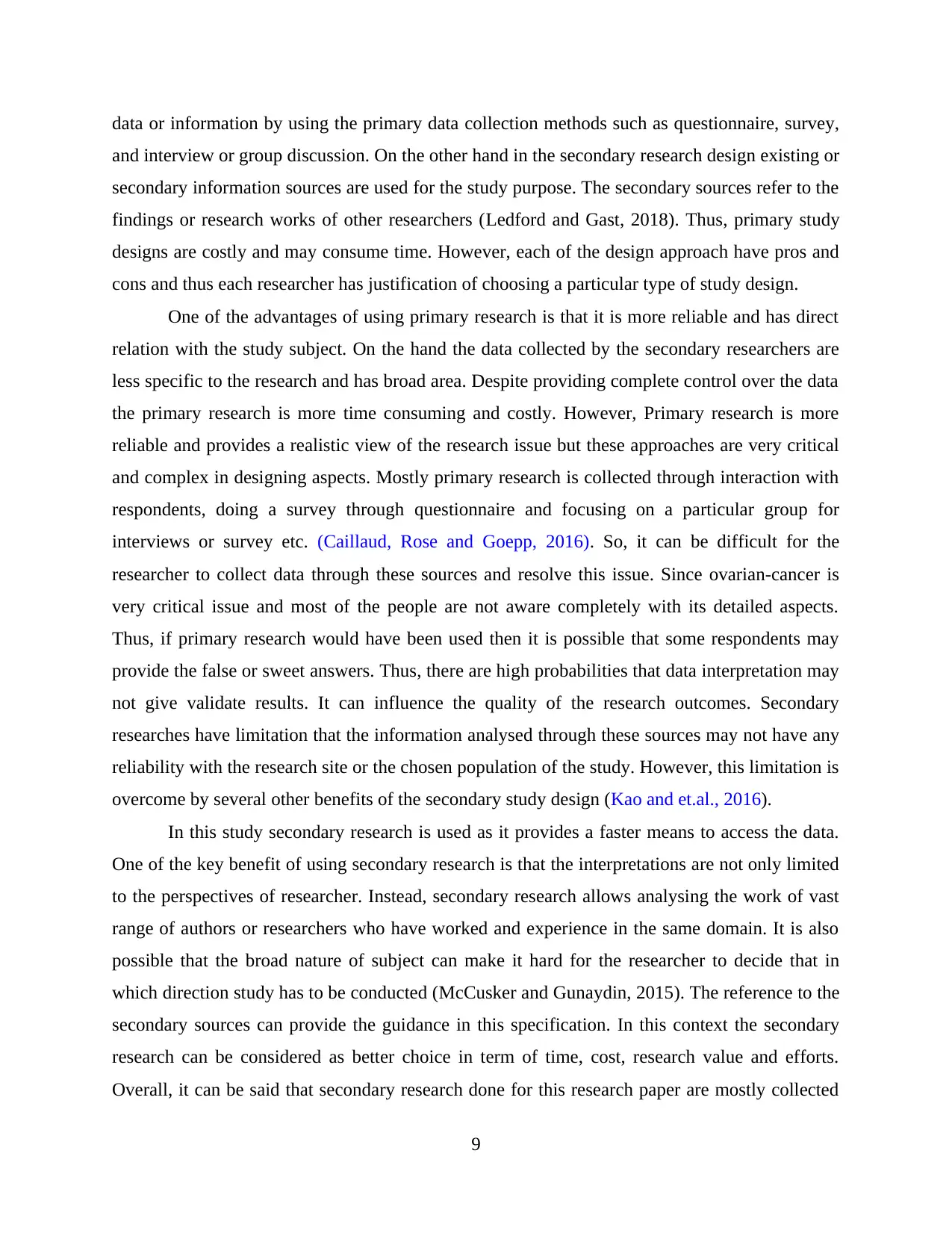
data or information by using the primary data collection methods such as questionnaire, survey,
and interview or group discussion. On the other hand in the secondary research design existing or
secondary information sources are used for the study purpose. The secondary sources refer to the
findings or research works of other researchers (Ledford and Gast, 2018). Thus, primary study
designs are costly and may consume time. However, each of the design approach have pros and
cons and thus each researcher has justification of choosing a particular type of study design.
One of the advantages of using primary research is that it is more reliable and has direct
relation with the study subject. On the hand the data collected by the secondary researchers are
less specific to the research and has broad area. Despite providing complete control over the data
the primary research is more time consuming and costly. However, Primary research is more
reliable and provides a realistic view of the research issue but these approaches are very critical
and complex in designing aspects. Mostly primary research is collected through interaction with
respondents, doing a survey through questionnaire and focusing on a particular group for
interviews or survey etc. (Caillaud, Rose and Goepp, 2016). So, it can be difficult for the
researcher to collect data through these sources and resolve this issue. Since ovarian-cancer is
very critical issue and most of the people are not aware completely with its detailed aspects.
Thus, if primary research would have been used then it is possible that some respondents may
provide the false or sweet answers. Thus, there are high probabilities that data interpretation may
not give validate results. It can influence the quality of the research outcomes. Secondary
researches have limitation that the information analysed through these sources may not have any
reliability with the research site or the chosen population of the study. However, this limitation is
overcome by several other benefits of the secondary study design (Kao and et.al., 2016).
In this study secondary research is used as it provides a faster means to access the data.
One of the key benefit of using secondary research is that the interpretations are not only limited
to the perspectives of researcher. Instead, secondary research allows analysing the work of vast
range of authors or researchers who have worked and experience in the same domain. It is also
possible that the broad nature of subject can make it hard for the researcher to decide that in
which direction study has to be conducted (McCusker and Gunaydin, 2015). The reference to the
secondary sources can provide the guidance in this specification. In this context the secondary
research can be considered as better choice in term of time, cost, research value and efforts.
Overall, it can be said that secondary research done for this research paper are mostly collected
9
and interview or group discussion. On the other hand in the secondary research design existing or
secondary information sources are used for the study purpose. The secondary sources refer to the
findings or research works of other researchers (Ledford and Gast, 2018). Thus, primary study
designs are costly and may consume time. However, each of the design approach have pros and
cons and thus each researcher has justification of choosing a particular type of study design.
One of the advantages of using primary research is that it is more reliable and has direct
relation with the study subject. On the hand the data collected by the secondary researchers are
less specific to the research and has broad area. Despite providing complete control over the data
the primary research is more time consuming and costly. However, Primary research is more
reliable and provides a realistic view of the research issue but these approaches are very critical
and complex in designing aspects. Mostly primary research is collected through interaction with
respondents, doing a survey through questionnaire and focusing on a particular group for
interviews or survey etc. (Caillaud, Rose and Goepp, 2016). So, it can be difficult for the
researcher to collect data through these sources and resolve this issue. Since ovarian-cancer is
very critical issue and most of the people are not aware completely with its detailed aspects.
Thus, if primary research would have been used then it is possible that some respondents may
provide the false or sweet answers. Thus, there are high probabilities that data interpretation may
not give validate results. It can influence the quality of the research outcomes. Secondary
researches have limitation that the information analysed through these sources may not have any
reliability with the research site or the chosen population of the study. However, this limitation is
overcome by several other benefits of the secondary study design (Kao and et.al., 2016).
In this study secondary research is used as it provides a faster means to access the data.
One of the key benefit of using secondary research is that the interpretations are not only limited
to the perspectives of researcher. Instead, secondary research allows analysing the work of vast
range of authors or researchers who have worked and experience in the same domain. It is also
possible that the broad nature of subject can make it hard for the researcher to decide that in
which direction study has to be conducted (McCusker and Gunaydin, 2015). The reference to the
secondary sources can provide the guidance in this specification. In this context the secondary
research can be considered as better choice in term of time, cost, research value and efforts.
Overall, it can be said that secondary research done for this research paper are mostly collected
9
Paraphrase This Document
Need a fresh take? Get an instant paraphrase of this document with our AI Paraphraser
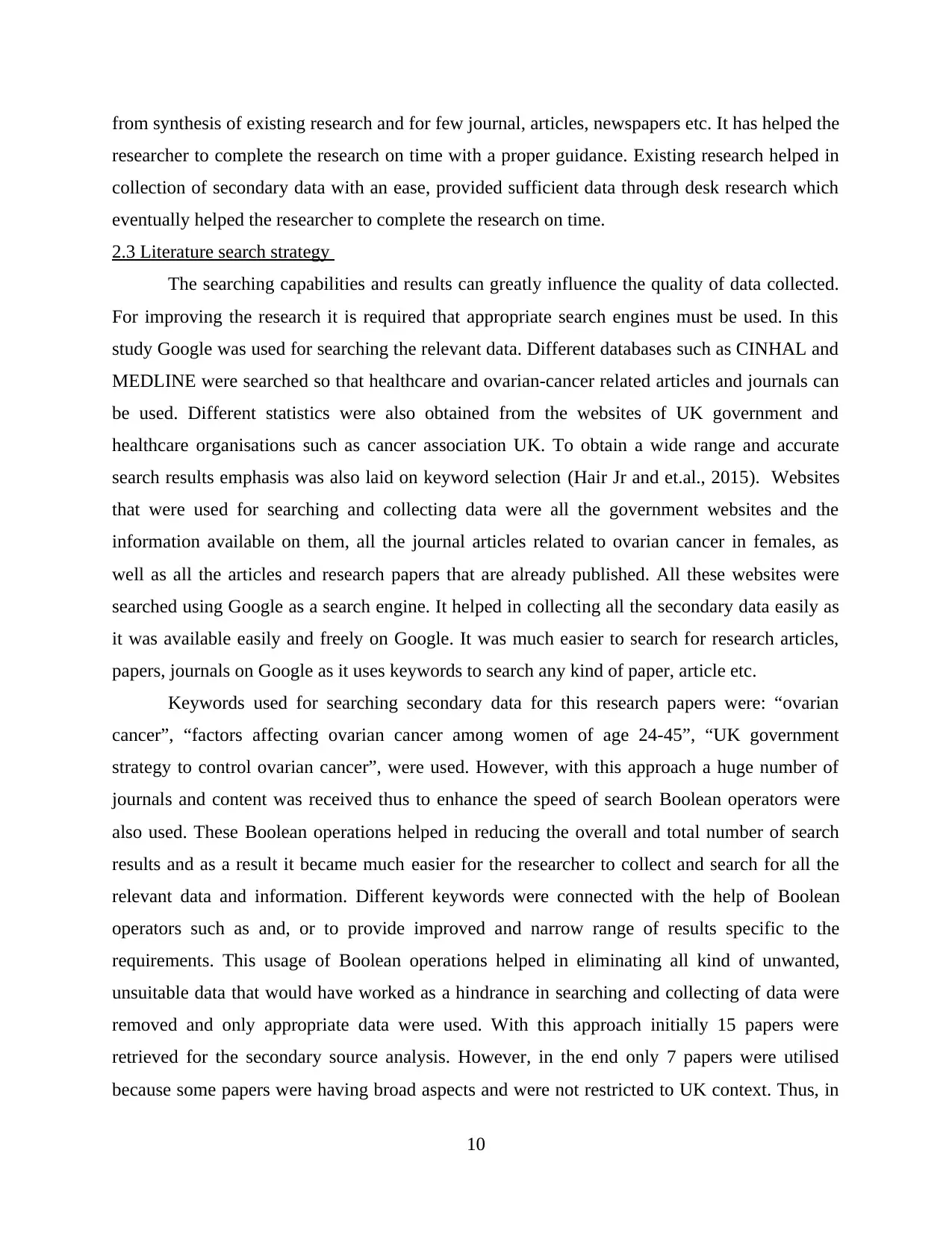
from synthesis of existing research and for few journal, articles, newspapers etc. It has helped the
researcher to complete the research on time with a proper guidance. Existing research helped in
collection of secondary data with an ease, provided sufficient data through desk research which
eventually helped the researcher to complete the research on time.
2.3 Literature search strategy
The searching capabilities and results can greatly influence the quality of data collected.
For improving the research it is required that appropriate search engines must be used. In this
study Google was used for searching the relevant data. Different databases such as CINHAL and
MEDLINE were searched so that healthcare and ovarian-cancer related articles and journals can
be used. Different statistics were also obtained from the websites of UK government and
healthcare organisations such as cancer association UK. To obtain a wide range and accurate
search results emphasis was also laid on keyword selection (Hair Jr and et.al., 2015). Websites
that were used for searching and collecting data were all the government websites and the
information available on them, all the journal articles related to ovarian cancer in females, as
well as all the articles and research papers that are already published. All these websites were
searched using Google as a search engine. It helped in collecting all the secondary data easily as
it was available easily and freely on Google. It was much easier to search for research articles,
papers, journals on Google as it uses keywords to search any kind of paper, article etc.
Keywords used for searching secondary data for this research papers were: “ovarian
cancer”, “factors affecting ovarian cancer among women of age 24-45”, “UK government
strategy to control ovarian cancer”, were used. However, with this approach a huge number of
journals and content was received thus to enhance the speed of search Boolean operators were
also used. These Boolean operations helped in reducing the overall and total number of search
results and as a result it became much easier for the researcher to collect and search for all the
relevant data and information. Different keywords were connected with the help of Boolean
operators such as and, or to provide improved and narrow range of results specific to the
requirements. This usage of Boolean operations helped in eliminating all kind of unwanted,
unsuitable data that would have worked as a hindrance in searching and collecting of data were
removed and only appropriate data were used. With this approach initially 15 papers were
retrieved for the secondary source analysis. However, in the end only 7 papers were utilised
because some papers were having broad aspects and were not restricted to UK context. Thus, in
10
researcher to complete the research on time with a proper guidance. Existing research helped in
collection of secondary data with an ease, provided sufficient data through desk research which
eventually helped the researcher to complete the research on time.
2.3 Literature search strategy
The searching capabilities and results can greatly influence the quality of data collected.
For improving the research it is required that appropriate search engines must be used. In this
study Google was used for searching the relevant data. Different databases such as CINHAL and
MEDLINE were searched so that healthcare and ovarian-cancer related articles and journals can
be used. Different statistics were also obtained from the websites of UK government and
healthcare organisations such as cancer association UK. To obtain a wide range and accurate
search results emphasis was also laid on keyword selection (Hair Jr and et.al., 2015). Websites
that were used for searching and collecting data were all the government websites and the
information available on them, all the journal articles related to ovarian cancer in females, as
well as all the articles and research papers that are already published. All these websites were
searched using Google as a search engine. It helped in collecting all the secondary data easily as
it was available easily and freely on Google. It was much easier to search for research articles,
papers, journals on Google as it uses keywords to search any kind of paper, article etc.
Keywords used for searching secondary data for this research papers were: “ovarian
cancer”, “factors affecting ovarian cancer among women of age 24-45”, “UK government
strategy to control ovarian cancer”, were used. However, with this approach a huge number of
journals and content was received thus to enhance the speed of search Boolean operators were
also used. These Boolean operations helped in reducing the overall and total number of search
results and as a result it became much easier for the researcher to collect and search for all the
relevant data and information. Different keywords were connected with the help of Boolean
operators such as and, or to provide improved and narrow range of results specific to the
requirements. This usage of Boolean operations helped in eliminating all kind of unwanted,
unsuitable data that would have worked as a hindrance in searching and collecting of data were
removed and only appropriate data were used. With this approach initially 15 papers were
retrieved for the secondary source analysis. However, in the end only 7 papers were utilised
because some papers were having broad aspects and were not restricted to UK context. Thus, in
10

order to meet the study aim only those papers were finally chosen which provided a critical
evaluation of the UK healthcare strategy (Schwarz and et.al., 2015).
There were some inclusion and exclusion criteria set for the searching of secondary data
which were set so that all the data collected would be relevant.
Inclusion and exclusion criteria for the research paper were that no articles that older than
5 years were used and included in this research paper. In other words age of all the
articles used were not more than 5 years
Further based on these criteria some journals did not match the inclusion criteria. As in
this secondary review secondary sources which were less than 5 years were not included
in the study.
Inclusion of the latest secondary sources help to analyse and review the latest strategic
changes in treatment of ovarian-cancer in UK. The language and the source were also
important criteria for the selection criteria. Since the study is based in UK only those
sources were preferred which were in English language and were of UK context. For this
research paper various papers were searched due to the set criteria most of them were not
used.
Many times the researcher encountered with research papers, journals, articles etc. that
were quite accurate with exact information and data but they didn't fulfil the inclusion
criteria. As it has already been explained above that almost 15 articles were searcher but
More than 50 percent of articles were rejected and were not used. Only 7 articles were
selected i.e. approximately 45 to 50 percent of articles, papers etc. were used out of all
the other searched data. Those articles consist of accurate data that was used in this
research paper.
2.4 Ethical considerations
Ethics provide the description of the moral behaviour which must be incorporated into
the research study. Ethical concepts are vital for making the study reliable and acceptable. The
integration of the ethics into the research must be encouraged. With the primary researches the
ethics are associated with the need of consent from the sample population, their privacy and
safety. Contrary to this in this study as secondary research is executed the key ethical
considerations are plagiarism and proper referencing. It is recommended that for the secondary
researches the sources must be authenticated and validate. However, it is the responsibility of the
11
evaluation of the UK healthcare strategy (Schwarz and et.al., 2015).
There were some inclusion and exclusion criteria set for the searching of secondary data
which were set so that all the data collected would be relevant.
Inclusion and exclusion criteria for the research paper were that no articles that older than
5 years were used and included in this research paper. In other words age of all the
articles used were not more than 5 years
Further based on these criteria some journals did not match the inclusion criteria. As in
this secondary review secondary sources which were less than 5 years were not included
in the study.
Inclusion of the latest secondary sources help to analyse and review the latest strategic
changes in treatment of ovarian-cancer in UK. The language and the source were also
important criteria for the selection criteria. Since the study is based in UK only those
sources were preferred which were in English language and were of UK context. For this
research paper various papers were searched due to the set criteria most of them were not
used.
Many times the researcher encountered with research papers, journals, articles etc. that
were quite accurate with exact information and data but they didn't fulfil the inclusion
criteria. As it has already been explained above that almost 15 articles were searcher but
More than 50 percent of articles were rejected and were not used. Only 7 articles were
selected i.e. approximately 45 to 50 percent of articles, papers etc. were used out of all
the other searched data. Those articles consist of accurate data that was used in this
research paper.
2.4 Ethical considerations
Ethics provide the description of the moral behaviour which must be incorporated into
the research study. Ethical concepts are vital for making the study reliable and acceptable. The
integration of the ethics into the research must be encouraged. With the primary researches the
ethics are associated with the need of consent from the sample population, their privacy and
safety. Contrary to this in this study as secondary research is executed the key ethical
considerations are plagiarism and proper referencing. It is recommended that for the secondary
researches the sources must be authenticated and validate. However, it is the responsibility of the
11
⊘ This is a preview!⊘
Do you want full access?
Subscribe today to unlock all pages.

Trusted by 1+ million students worldwide
1 out of 30
Related Documents
Your All-in-One AI-Powered Toolkit for Academic Success.
+13062052269
info@desklib.com
Available 24*7 on WhatsApp / Email
![[object Object]](/_next/static/media/star-bottom.7253800d.svg)
Unlock your academic potential
Copyright © 2020–2025 A2Z Services. All Rights Reserved. Developed and managed by ZUCOL.





